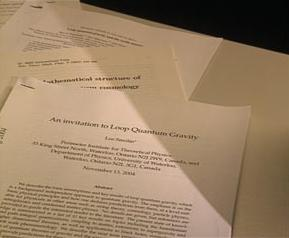Mikrowelt: Quantengravitation
From preprint to e-print

In 1991, the theoretical physicist Paul Ginsparg of Los Alamos National Laboratory was the first to program a simple archive system that imposed order onto the flood of preprints. The archive assigned numbers according to a uniform numbering scheme, saved their electronic versions and made them accessible over the Internet. Since then, the status of preprints has changed: They have evolved into e-prints, electronic articles. In research areas like string theory, they are now a more important means of communicating results to the community than ordinary printed articles.
[ Sitemap ]
[ info ] This website was created by the MPI for the History of Science.
 Scene
Scene


 1st Slide
1st Slide
 Branching Point
Branching Point
 Module: Mikrowelt: Quantengravitation
Module: Mikrowelt: Quantengravitation Sequence: Einstieg Quantengravitation
Sequence: Einstieg Quantengravitation Branching Point: Quantum gravity
Branching Point: Quantum gravity Slide: The limits of general relativity
Slide: The limits of general relativity Back
Back

